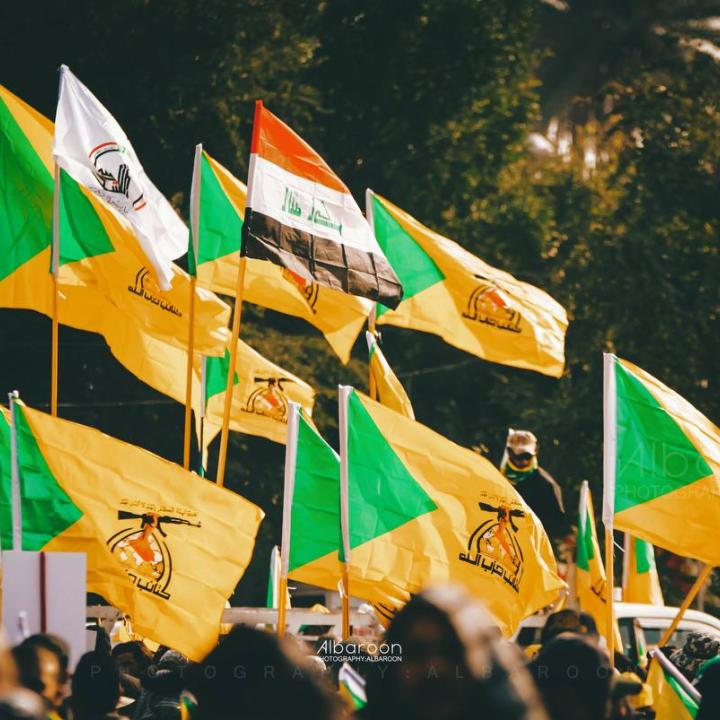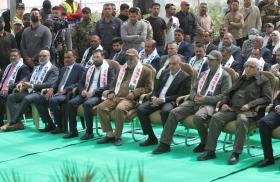
Profile: Kataib Hezbollah
Apr 1, 2021
Also available in
Updated October 21, 2023

About the Authors
Brief Analysis
Part of a series: Militia Spotlight: Profiles
or see Part 1: How to Use Militia Spotlight: Profiles
Kataib Hezbollah is the premier militia in Iraq, operating under Iran's direct command and fielding a wide range of cells responsible for kinetic, media, and social operations, some bankrolled by the Iraqi state.
Name: Kataib Hezbollah (KH) (Battalions of the Party of God).
Type of movement: Tier 1 fasail (armed group). Kinetic military operations (domestic and foreign). Social and political wings. Parent organization. De facto branch of Iran's Islamic Revolutionary Guard Corps-Qods Force (IRGC-QF).
History and objectives:
- Coalesced from "special groups" operated by the IRGC-QF in 2005-2007.
- Listed by the United States as a Specially Designated Global Terrorist group in 2009 for attacking U.S. forces and destabilizing Iraq.
- Strongest individual faction in Iraq's Popular Mobilization Forces (PMF), with control over key departments (chief of staff, security, intelligence, missiles, anti-armor).
Chain of command:
- Iran. Clear and convincing evidence shows that KH is subordinate to and partly financed by the IRGC-QF. Credible evidence shows that KH carries out specific actions under the IRGC-QF's instructions, direction, or control. The preponderance of evidence shows that Iran provides KH with financial assistance, military assistance, and intelligence sharing, as well as help in selecting, supporting, and supervising its leadership.
- Internal leadership. KH is nominally governed by a Shura Council with a secretary-general, five deputies, and at least thirty-three total members, plus external “overseers” from the IRGC-QF and/or Lebanese Hezbollah.
- Multiple personal and financial powerbases exist within KH, partly aligning with different Shura Council members. Since a leadership election on July 29, 2021, KH secretary-general Abu Hussein (aka Ahmad Mohsen Faraj al-Hamidawi) was asked to step down in favor of Bassem Mohammed Hasab al-Majidi, who was backed by Abdul-Aziz al-Mohammadawi (aka Abu Fadak). Abu Hussein refused to surrender his post, however, and the group is stuck in an interregnum of disputed leadership.
- Partly financed by the Iraqi state. KH operates the state-funded 45th, 46th, and 47th Brigades of the PMF. Chain of command nominally runs through the KH-dominated Popular Mobilization Commission in the Prime Minister's Office, then up to the prime minister. In practice, KH's PMF brigades frequently disobey the government chain of command while legally remaining organs of the Iraqi state.
Affiliate relationships:
- Rivalry with Asaib Ahl al-Haq, the Badr Organization, and other resistance factions over profile and recruitment, giving way to coordination when such factions are all threatened.
- Dominant and founding member of the Iraqi Resistance Coordination Committee (al-Haya al-Tansiqiya lil-Muqawama al-Iraqiya, or Tansiqiya for short).
- Member of the Islamic Resistance of Iraq.
Subordinate elements:
- 45th, 46th, and 47th Brigades of the PMF, an Iraqi state organ, plus Unit 313 and Unit 101 (both under Abu Fadak).
- KH Special Operations and KH Engineering/Explosives, both under Abu Hussein.
- Media wings:
- The preponderance of evidence suggests that at least part of Sabereen News (previously described as the KH Baghdad Media Cell) is controlled by KH.
- Kaf (various platforms), Kyan kF, Unit 10,000, Qeyam.Post, Almukhber, Shabakat al-Ilam al-Muqawama.
- Al-Etejah TV.
- Facade groups:
- Qasem al-Jabbarin, Raba Allah, Ahlul Marouf, Alwiyat al-Waad al-Haq.
- Cultural and social wings:
- Ahd Allah Islamic Movement, Majlis al-Tabeat al-Thaqafiyya (Cultural Mobilization Council).






